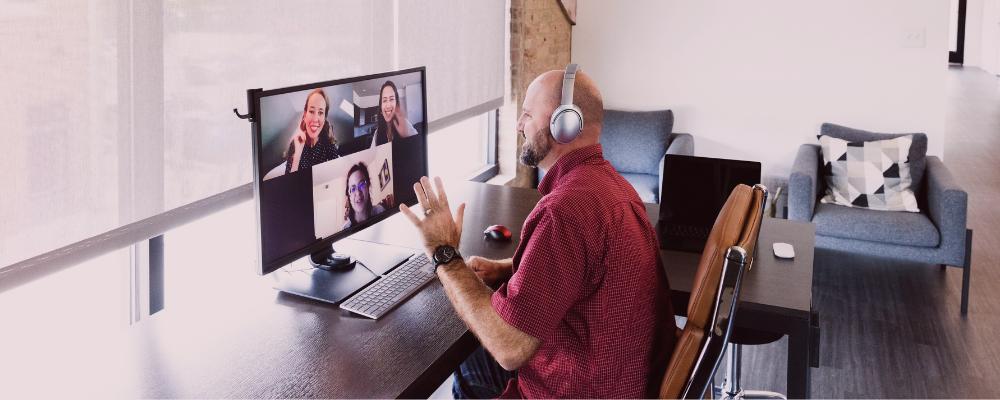Let’s be real: Remote management is hard. Some managers are juggling teams in different cities, while others are strategizing across multiple time zones. And without the daily face-to-face interaction expected in a typical office setting, a remote manager might flounder to generate engagement or foster a shared culture among a dispersed team.
But where some managers view the implications of remote work as a barrier, others leverage their dispersed team to their advantage. In fact, some of the most successful businesses in the world right now, ranging from Google to Facebook, are implementing fully-remote teams dependent on remote management.
Remote teams are far from the “new normal,” they’re simply normal — and like all other routine areas of business, they’ve drummed up quite a few best practices to keep in mind. Fortunately, we’ve put together a list of remote management best practices, as told by more than 30 remote companies, to help managers across the globe confidently lead their dispersed teams in a shared culture and connection.
- Offer opportunities for connection and company culture
- Establish a precedence for boundaries
- Build trust with your people
- Set clear expectations
- Plan for collaboration
- Build interpersonal relationships
- Communicate as often as possible
- Use video to your advantage
- Reimagine remote meetings
- Create a culture of feedback
- Find the right remote management tech
- Celebrate both the team and individual wins
Offer Opportunities for Connection & Company Culture
Connection is the life-blood behind remote management.
“Offer a range of opportunities to connect: virtual happy hours, lunches, book clubs (work-related books or not), contests, virtual background theme days, centralized help wiki/discussion boards, a place for employees to post questions and get answers, and small gestures of appreciation such as gift cards for coffee or cookies.” — Kristie J. Loescher, Assistant Dean for Instructional Innovation at McCombs School of Business, The University of Texas at Austin
“Company culture is easy to reinforce when we all share the same square of carpet five days a week. In a remote environment, there are no corridors for colleagues to cross-paths in. Leaders in remote companies need to be proactive and create opportunities for informal communication to happen, designing an atmosphere where team members feel comfortable reaching out to each other to converse on topics unrelated to work.
- Setting up virtual coffee chats with others in the company,
- Using the Slack donut app to randomly choose a coffee partner to facilitate introductions,
- Informal social calls organized within specific teams to get to know each other on a more personal level,
- Using Slack channels for informal communications throughout the company, whether it’s a team-specific channel or a channel dedicated to a specific hobby.” — Jack Turner, Deputy Director of EU and International Policy at Medicines and Healthcare Products Regulatory Agency
“We have a daily drop-in video chat session that any of our employees are welcome to join. It’s a chance to chat about things other than work, and also — most crucially — a chance to keep and grow those all-important interpersonal relationships. … The sessions don’t have to be long (10 to 20 mins is fairly typical) and your organization might choose to do them just once or twice a week. Additionally, if you have the chance to work occasionally in a physical location with your colleagues, then this is also a great way to feel part of the team. This could be one day a week working back at the office, or a once-a-month team meeting in a location such as a café or restaurant.” — Leon Ho, Founder & CEO of Lifehack
“Maintaining culture requires top management support and bottom-up employee engagement. Get volunteers for “culture cheerleaders” from all levels and functions to champion your initiatives. This also establishes a feedback loop that ensures your implementations are valid. “Culture Cheerleaders” organize regular social events such as virtual coffee roulettes and game nights to foster informal interactions and promote work-life balance.” — Gajus Kuizinas, Co-founder & CTO at Contra
“Be a mentor: We’re starting to see a shift in leadership style towards a more empathetic, coaching kind of leadership. Managers are stepping up to not only lead their teams through daily tasks but also take a more vested interest in employees’ skills and their development. Mentoring employees can be an effective way to strengthen teams, drive development, and create leaders for the future. It shows employees that they are valued and helps them learn new skills within the workplace. If you have too many team members to mentor, try connecting employees with other company leaders to give everyone a chance to participate.” — The McQuaig Institute of Executive Development
“It helps if you find fun and creative ways to check in with your team. Maybe send out motivational videos once a week. You can also organize a virtual happy hour with some mocktails and an emphasis on non-work talk. These stress management tools go a long way to keeping people socially engaged and content.” — Renata Pellino-Porter, Founder of Renata Porter Limited
Establish a Precedence for Boundaries
Boundaries are an integral aspect of remote management.
“Work-life balance is essential during stressful times. As the manager, you should strive to model healthy behavior by setting your own start-stop times and encourage your team to do the same. Avoid emails or calls outside of work hours whenever possible. Recommend employees take mini-breaks during the day by moving between meetings and eating lunch on the porch or in another room. Finally, encourage downtime activities that provide mental breaks (and keep people’s hands too busy to snack) such as sewing, puzzles, crosswords, writing fiction or poetry, and painting or drawing. Consider having contests or displaying pictures of artwork, finished puzzles, and needlework in a virtual art gallery.” — Kristie J. Loescher, Assistant Dean for Instructional Innovation at McCombs School of Business, The University of Texas at Austin
“Some people treasure their homes while others just view it as a place to sleep. Some live alone while others have roommates or a whole family. We have to make teams aware of everybody’s situation. This will change the way we perceive people and we can be more empathetic to their situation. Remote work has compelled us to learn a lot more about how a company looks after their employees. We have to focus on what really matters to employees. It begins with doing small things to make work from home more enjoyable. It also involves being more flexible with work hours, implementing better ways for employees to take holidays, and overall helping folks manage their life better.”— Enrico F., Director of Engineering OLX Group

“Establish boundaries. It’s important for your team to know that working from home should not mean working 24/7. Given that we’re working and living in the same environment, the lines between work and life can easily become blurred. Happy, successful remote workers establish clear, inviolable boundaries. They differentiate between work hours and off-hours, as well as between their workspaces and the rest of their homes.” — Greg Hanover, CEO of Liveops
“Use goal-setting as a way to address deeper issues regarding a person’s personal work experience. As we said, it’s important to focus on OKRS, but strike a balance. For example, encourage your employees to block off time for “family” or “personal” time. If your direct report is experiencing stress from working at home with kids present, seeing “personal time” or something similar on their calendar will remind others that this time should not be interrupted. Being able to strike a balance between work and home will be key in making sure your employees are more productive and can achieve their goals.”— Katherine Johnson & Jennifer Johnson, Chief People & Legal Officer, Head of Compliance at Storj Labs
Build Trust with Your People
Remote management hinges upon trust between employees and managers.
“One of the biggest challenges for leaders who are used to having their teams within arm’s reach at all times is to trust them to get the job done when they can’t check in every few minutes. Resist the urge to micromanage. Trust your employees to be adults, and trust yourself that you picked a good team that will continue to work at a high level. When employees feel you don’t trust them or don’t think they are being productive, it shows in their work. Check in with your employees enough to collaborate and stay on the same page, but don’t babysit them.” — Jacob Morgan, Founder of The Future of Work University and The Future If Community
“When asking a colleague to work on a new project, I defer to them to tell me when they will complete it. Setting deadlines this way allows me to see how quickly an employee gauges his or her time, puts the onus on them to meet the deadline, increases their ownership of the project, and, if successful, increases our mutual trust. If unsuccessful, it provides a learning opportunity for skills such as better time management, speaking up, and prioritization.”— Kelly Lyons, Founder of Lyonshare
“Autonomous work is enabled by transparency. Team members need to have access to the right information at the right time, so it’s crucial to be diligent about documentation. That goes for every meeting, decision and action item, onboarding and staff processes, experiments, and metrics — almost every detail of your business.” — Ariel Camus, Founder of Microvers
“In organizational behavior, we understand cultures’ approach to debate and disagreement in unique ways. What passes for normal discourse in Germany or France may be seen as offensive in Asia. It is important to state the objective and spell out the purpose ahead of time – simply put in the room what would otherwise be an implied understanding if everyone were coming from the same background. There are cultural differences in how trust is established, some cultures primarily establish trust from the head, and others from the heart. The U.S., U.K., Germany, and Scandinavia form trust-based on task effectiveness. In other cultures, such as China, Brazil, and Saudi Arabia, there is a greater emphasis on relationships when establishing trust. When working across cultures, it’s vital to know how the other person may view gestures of trust-building, and lean into that style.” — Mattias Bergstrom, Chairman at Internet of Everything Corp

“It can be hard to trust your employees that they are committed to their work when you don’t see them. Remember that you will build trust by trusting them first. Establish ongoing, meaningful communication with each employee. Adapt to the specific needs of each individual but ensure you are in touch consistently. Consciously invest time to be available for each employee.” — Anne Koopmann-Schmidt, Founder Lead Like You
“Beware of micromanagement: One of the dangers of having a distributed team is it’s so easy for leaders to fall into bad habits. Checking-in too often or giving too much oversight can derail productive teams. No one wants to feel like they aren’t trusted and that’s exactly the message micromanaging sends. To a manager, it might seem like they’re merely being proactive and helpful but to employees, the feeling of being watched and monitored can send them running for the door. Those in leadership roles need to find a way to balance being supportive without being overbearing. When in doubt, give employees more independence and see what they produce when left to their own devices. Once you have that baseline, you can make adjustments from there if needed.” — The McQuaig Institute of Executive Development
“The simplest way of achieving trust from the outset is through an auto-reinforcing mechanism. Leaders must act with trust from the outset, providing the social proof to other team members that trust does indeed exist. Senior team members should also be encouraged to entrust tasks to junior members at the early stages of group formation or project work.” — Joe Thornton, Partner at PlayfairCapital
Set Clear Expectations
Expectations can pave the way for a fruitful remote management experience.
“Set clear guidelines and expectations from the beginning, including how you want them to work, the quality of the work, and when they need to be online and available. I’ve found this works for full-time and part-time employees. Even with the flexibility of remote working, being clear about needing someone online for certain hours can make a huge difference. Do it from the start to avoid awkwardly having to backpedal and set expectations down the road.” — Jacob Morgan, Founder of The Future of Work University and The Future If Community
“Clear routines helps you and your team have increased accountability in accomplishing work and helps develop consistent behaviors. When it comes to developing and sticking to a routine, create a schedule that takes into account both your personal and professional obligations. Prioritize the things most important to you (for me it is working out and time-zone boundaries) and work around the things that are more flexible. This approach can be personalized for people that need more structure, by creating a more rigid schedule, having consistent working hours, etc. and for people like me it creates anchors in which to act around, and builds in the necessary spontaneity to work according to energy levels.” — Ali Greene, Co-Founder at Remote Works
“As a boss or a manager, you need to clearly define the tools and methods of communication. Define how you want to learn about tasks and updates. Discuss when it’s the best time to communicate in order to eliminate distractions, discuss what to do when your employee is not busy. Best time to do it is in the first week to set precedent, and adjust from there as needed.” — Sharon Koifman, Founder and President of DistantJob

“Employment contracts have historically been based on hours worked. The 9-5 working day has framed most office environments for decades, but our research findings make clear that the time-input approach may be outdated. For employers of knowledge-economy workers, considering how contracts can better reflect impact and outcomes may be a more effective way to measure productivity than time spent at a desk. Employees who are clear about what needs to be done and what results they are expected to deliver are more effectively remunerated on added value, rather than on presenteeism.” — Alain Dehaze, CEO of The Adecco Group
“During 1:1 meetings allow time for communication about personal experiences, and make sure to remind people it’s ok to take a break and address family needs, personal needs, or take a mental health break — work is important, but burnout is real, so be flexible. During 1:1 meetings, establish team norms. Set ground rules around availability, Slack messages, and make sure to gain clarity around when someone is available or away focusing on work they don’t need to be interrupted. As a manager, you can help set the tone by not slacking people late at night, or even displaying work hours for different time zones if your workforce is in different countries.” — Katherine Johnson & Jennifer Johnson, Chief People & Legal Officer, Head of Compliance at Storj Labs
Plan for Collaboration
Collaboration is key for effective remote management on dispersed teams.
“One of the leading concerns of most employers when it comes to building remote teams is that team members cannot be as collaborative without supervision and on-site management. So it is advisable to use tools that enhance real-time collaboration such as Google’s tools (like Docs, Sheets, Slides, etc) designed to allow teams to create and edit files simultaneously in real-time, Miro, Igloo and Quip.” — Arthur Kakande, Communications Lead at Pollicy
“It can be challenging for more introverted colleagues to participate in-group meetings — and even more so in a virtual environment. Team leads can help compensate for this by directly asking these participants for their input. On the same line, stay in tune with participants’ expressions and body language. If you see they may be trying to enter the conversation, give them the chance to speak.” — Justin Bariso, Founder of EQ Applied
“There are certain times when someone needs more individualized attention. If I notice dropped tasks, missed deadlines or miscommunications, I’ll institute a shared “to do” list with my direct report. I’ve used both Asana and Google Sheets for this, my preference is the latter. The direct report owns the “to do” list and should keep it up to date daily. I had a new direct report who was having trouble, so we had a daily 5–10 minute call where we discussed this list. It ensured that we were aligned and helped him stay organized. Eventually this call turned into once a week and then was completely phased out. If he needed feedback after our calls had stopped, he could tag me in the spreadsheet, where we could communicate efficiently.” — Kelly Lyons, Founder of Lyonshare
Build Interpersonal Relationships
Interpersonal relationships inform the remote management best practices for your unique team.
“Ask questions. This is one of the most powerful tools of an effective manager. The basis for managing well is listening, observing, taking note of what motivates your teammates, and digging into the responses to your questions. I usually gather questions before I meet with my team members one-on-one so I am prepared and can guide the conversation toward understanding them better. Asking questions helps you adjust your leadership style to the individuals on your team. It also ensures that they feel understood and heard, which are important pillars of inclusion and belonging.” — Lena Reinhard, Vice President of Product Engineering at CircleCI
“A boss needs to build trust with employees so they can come to them with any issue and know that their mental health is key to the success of the company. This involves creating a consistent “asshole free environment” where everyone works as a team. The bosses should get to know people on a personal level, the names of their kids and pets, and their hobbies. Like a therapist that by discussing everyday stuff, can read between the lines to figure out how things are going. That trust and focus on mental health while encouraging people to live life, is key to having much less burnout.” — Sharon Koifman, Founder and President of DistantJob

“Don’t try to replicate one-to-one what you used to do in person; instead, figure out what purpose your activities served, and build to achieve this purpose. One example to illustrate my point: if people miss the watercooler, it doesn’t necessarily mean you need a virtual one. What was the watercooler good for? A space for spontaneous interactions with people beyond one’s own team, build connections, and maintain a sense of belonging to a larger team? If that’s it, then how do we achieve that?” — Lena Reinhard, Vice President of Product Engineering at CircleCI
“Focus on the people, step away from the tactical. As Project Managers, we are charged with the oversight of timelines, budget, and scope (to name a few) and it’s very easy to have tunnel vision in terms of those tactical deliverables. We must make a deliberate effort to take off our tactical hat and regularly replace it with our relationship hat. In my experience, the most important pieces of any project, any team, any business are the people and their engagement. Not just internally, but externally, too. The higher the rate of engagement, the more successful the project.” — AWH, Digital Product Firm
Communicate as Often as Possible
You can never over-communicate in remote management.
“Over-communicate information. When in doubt, communicate more. I’ve found that it’s helpful to include the same info via different tools, as team members may check one more than the others.
I have a channel in Slack specifically for #announcements. Once we’ve finished a particular discussion, I re-post a summary in the channel (as well as in Confluence or JIRA when appropriate). This (hopefully) ensures that everyone sees the info.” — Merissa Silk, Chief Product and Technology Officer at fundingport
“Communicate visually as well. Just because you’re not sitting next to a whiteboard doesn’t mean you can’t draw together. Draw stuff, snap a pic, and send it to team members. Use tools like Miro or draw.io for creating digital sketches. When in doubt, screen share, screen record, or annotate. I like the Chrome plugin Awesome Screenshot for videos and annotating.” — Merissa Silk, Chief Product and Technology Officer at fundingport
Use Video to Your Advantage
Video will be unbelievable helpful to guide remote management.
“When designers provide feedback on a design, they usually do it in the form of text comments. While that feedback can give enough details for the other person to get a sense of what you mean, you still miss an opportunity to convey the tone of voice and emotional reactions. Plus, too much text naturally makes design feedback less effective — nobody enjoys reading long paragraphs of text. So when it comes to remote design, it’s much better to record your feedback as video. Use built-in tools like QuickTime Screen Recording, upload the file to Google Drive or Dropbox, and attach the file to the task.”— UX Planet, Resource for User Experience
“To keep a distributed workforce engaged and ensure remote employees don’t feel “out of the loop,” it’s important that company leaders maintain transparency. Hold all-hands meetings virtually using tools that not only let team members hear managers, but also see them. Holding a video conference on a regular basis instead of a regular audio call is an important way to maintain transparency between managers and workers. Sharing this information on public channels using Slack and Microsoft Teams is another way to keep team members equally informed as they’re working from home.” — John Boitnott, CEO of Boitnott Consulting LLC, Writer & Contributor at The Motley Fool

“When I tasked a new employee with putting together our business dashboard, there were so many mistakes in the first draft that I wasn’t sure whether the employee was not clear on my expectations, was missing skills required to complete the task or simply had put little effort into it. … I proceeded to screen share with him as I fixed each mistake so that he could see how to do it and what the final product should look like. For the next 8–10 weeks we painstakingly repeated this process until his Excel skills and attention to detail were sharpened.”— Kelly Lyons, Founder of Lyonshare
“If your meeting is video-enabled, have everyone turn their camera on — even if some participants are together in a conference room. This is a best practice for two reasons: First, it levels the playing field. Everyone is on-screen, seeing one another, and remote participants don’t get left behind if those in a conference room revert to traditional face-to-face interaction. Secondly, and most important, 50% to 90% of communication is nonverbal. While we can’t (yet) replicate the energy of an in-person meeting, we can improve it dramatically by being able to see each other.” — XPLANE Consulting
Reimagine Remote Meetings
Meetings can, and should, have multiple forms in remote management.
“Each meeting has a clear agenda and a Google doc attached. Before meetings, leads ask participants to review the agenda and add any items for discussion. By attaching a Google Doc attendees are forced to brainstorm in text, rather than by doodling on a whiteboard, which ensures ideas and actions are clearly captured with less room for interpretation. Having a shared document for every meeting also allows people to contribute questions and input in advance of the meeting and follow up on actions afterward, without having to attend the meeting at a set time.” — Jack Turner, Deputy Director of EU and International Policy at Medicines and Healthcare Products Regulatory Agency
“Ask yourself if you really need a meeting or if you can get to the outcome in another way. Can you sum up the core of your meeting in an email or a short video message instead? Or, if your team has a set of recurring meetings for discussing any updates or blockers, can you solve your problem in the next meeting? Avoid the temptation to “invite everyone just in case” and focus only on those people who are key to the meeting’s success.” — UTOPICODE, International Dev Community
“While written communication is the lifeblood of a remote work environment, a lot can get lost in the medium. Humor and tone can be easily misinterpreted, and there’s no chance to hear a person’s voice, see the expression on their face, or read their body language. In contrast, virtual meetings are a chance to get those emotional cues, and to build rapport with your teammates. (Caution: Just be careful not to schedule too many meetings, or your team may feel like they don’t have enough time to actually get work done.)” — Justin Bariso, Founder of EQ Applied

“When you’re choosing a time for your meeting, consider checking calendars to see people’s working hours first. Try to cluster meetings together instead of spreading them throughout the day to create large windows of uninterrupted work time. Avoid constant emergency or ad-hoc meetings, as these can break flow during an employee’s regular day. Encourage team members to keep their calendars up to date. In this way, the people scheduling meetings will have a better understanding of the dates and times that work best for everyone.” — UTOPICODE, International Dev Community
“Leading an online meeting is like being an MC of a production. In addition to leading the agenda, there are also connectivity issues, chat windows, document management, and other considerations to manage. If one person is assigned to be the scribe (documenting the meeting, managing the document handling and chat windows, etc.), the facilitator is freed to focus on successfully driving the agenda and ensuring each participant is included and heard.” — XPLANE Consulting
“Research has shown that our attention spans, especially in remote meetings, are around 10 minutes. After that, people drift off, check their other browser tabs and so on. Sharing your screen and talking to a slideshow for 30 minutes is likely to send people to sleep. So every 10 minutes or so, consider how you could engage participants or check in with them in some way. And looking at the flow of your meeting, how could you mix up participation formats so it’s not just presenting or open discussion in one big group? For example, use a Liberating Structure, get participants to type something in the chat, have them collaborate on a shared doc or tool (e.g. Google docs or Mural).” — Lisa Gill, Founder of Reimaginaire
Create a Culture of Feedback
Feedback is an inherent aspect of fruitful remote management.
“We decided to implement regular “pulse surveys” that were sent every week to all employees. In these surveys we asked whether they felt they were being closely supported by their manager, whether they still felt connected to team members, and if they maintained trust in the company’s strategy and leadership during the crisis.”— Caroline Leroy, VP of People at PayFit
“Performance management is all about communication and transparency. This is particularly true when working from home. Regardless of where or what hours they’re working, employees and agents need someone to report to, provide feedback, and suggest ways to improve performance.” — Greg Hanover, CEO of Liveops
“Regular feedback is key to improved relationships. Get very regular updates on projects, working environment, how they are feeling (individual & with co-workers) and suggestions for improvement. These conversations need to be open and upfront to achieve the best outcomes. These are best done by video calls/conferencing.” — Rob Tyson, Recruitment Owner, Mining International

“A system of ‘Continuous Feedback’ can help empower & develop remote workers to seek feedback for their own individual growth, staying connected with managers and peers in a way that offers benefits way beyond the individual. It provides a platform which encourages more frequent, high quality, 2-way meaningful conversations to happen, fuelling the opportunity to develop stronger relationships, interdisciplinary skills and autonomous teams. As more individuals become consumers and producers of feedback, they help grow a vibrant network of ‘value creators’ where feedback becomes a currency that has value for individuals, teams, and the organisation itself.” — Jamie Prangnell, Head of Product at Bowland Solutions
“Giving difficult feedback to team members is one of the most frequently utilized skills — and most notoriously difficult. It’s even tougher to do well in a remote environment, where a manager cannot directly read the other person’s body language. The key is to give your managers a framework in your remote leadership training for how to best give feedback, so they’re not sugar-coating their feedback or being too brusque in their delivery. For instance, share a framework that focuses on sharing the intention of the feedback and stressing specific observable behaviors, so that their employees are more likely to internalize that feedback and change their behavior.” — Claire Lew, CEO of Know Your Team
Find the Right Remote Management Tech
Your chosen technology can make or break remote management.
“Before you can go remote, you need to find the right technology to support your team. There are many innovative, flexible options out there. The approach you take will depend in part on your business and IT needs. For example, as a virtual call center, you can use an on-demand contact center solution that’s hosted in the cloud by an application service provider. Another option is to leverage your existing platform and integrate it with other solutions to complement or enhance your current environment.” — Greg Hanover, CEO of Liveops
“Your work instructions might be as clear as day and night, but there’s only little that your team members can accomplish without the right tools. Do not assume that the work laptops and mobile phones they have are sufficient. What software is required? Do they need cameras, headphones, microphones, and other tools to make their work more efficient? I would also recommend coaching your employees on how to work remotely with each other and escalate ineffective or uncomfortable virtual communications.” — Andy Pan, Principal Trainer and Consultant at Right Impact

“There are many communication tools that aid remote teams in being efficient as well as re-creating the “water cooler” atmosphere of in-office interactions, such as a “random” channel on Slack, a channel-based messaging platform. However, the team should understand when and how to use the communication tools you adopt—when to use messaging, email, call a meeting, or pick up a phone to discuss or transfer info. For example, your organization might prefer to have all project info updated in a project management tool such as Asana and only GIFs and memes shared on the “water cooler” channel in your messaging app. Clearly outline those expectations to all employees.” — Bernard Marr, Founder and CEO of Bernard Marr & Co.
* Find our recommendations for remote management technology here! *
Celebrate Both the Team and Individual Contributors
Remote management should celebrate both team and individual wins.
“Remote teams must be more intentional than in-person teams about the way they celebrate wins and recognize one another for a job well done. Some companies use corporate social media channels to recognize teammates, and others have specific programs such as an employee of the month. Other organizations have ways for individuals to recognize each other in group meetings so that their accomplishments don’t fly under the radar.” — Bernard Marr, Founder and CEO of Bernard Marr & Co.
“Remote developers can either robotically code and deliver on assigned tasks, or they can be a more conscious part of successful development of the goal. It is the leader’s job to share the vision of the larger goal to give purpose to the developers, to engage them to a degree they feel their own importance to the company and not just the coding tasks. Let them know how and why they matter, and their contribution will matter even more. Do not limit remote developers to routine, easy coding. Give them challenging and important work, and they will give you loyalty and greater contributions.” — Steven Bustin, VP of Sales and Marketing at Dev Partners
“It’s easy to lose sight of the ‘why’, especially when working from home — there is laundry staring at you from across the room, the kids need to be driven to school, the dog needs to go outside. The distractions are endless and once you resume your workday, it’s easy to simply focus on the task at hand. Keeping the vision, the ‘why’ at the forefront is challenging and is our responsibility to continually reinforce. An easy way to consistently communicate this vision is by reflecting the vision as part of the deliverables you include in your project roadmap. Reviewing the overall roadmap during your recurring status meetings serves as a continual reminder of the vision.” — AWH, Digital Product Firm
Strive for Effective Remote Management Daily
Remote teams open the door for talent without borders and connection without limitations. Though a lack of physical interaction might appear as a barrier to engagement and communication, the right tools, expectations, and culture can create a dynamic, highly-effective team. By establishing boundaries, planning for collaboration, and utilizing video software to reimagine remote meetings, you can ensure effective remote management each day.
Above all, remember that remote work is highly personalized — what works for one remote team might not be as helpful for yours. So long as you continue to tweak your remote management to answer the needs of your employees while still delivering on company culture and objectives, you can confidently lead your dispersed team towards success.



[…] lesson behind the “Dear Intern” trend. More than anything, the trend showed how crucial supportive management is after instances such as […]